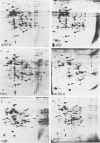Abstract
Fifteen Frankia strains from five different plant species were analyzed by two-dimensional polyacryl-amide gel electrophoresis to determine their relatedness by comparing the polypeptide patterns obtained. Three major subgroups (A, C, and D) were found in the Alnus-Comptonia-Myrica cross-inoculation group. An isolate from Purshia tridentata had a unique protein pattern and represents a distinct group of frankiae. Members of group A were isolated from root nodules of Alnus incana subsp. rugosa and Alnus viridis subsp. crispa. Group C organisms were from A. incana subsp. rugosa and Comptonia peregrina nodules, and group D organisms were from A. incana subsp. rugosa, A. viridis subsp. cripsa, and Myrica pensylvanica root nodules. Isolates from each gel group were obtained at several widely separated geographical locations. The results indicate that two-dimensional polyacrylamide gel electrophoresis is useful for identifying Frankia isolates.
Full text
PDF





Images in this article
Selected References
These references are in PubMed. This may not be the complete list of references from this article.
- Baker D., Newcomb W., Torrey J. G. Characterization of an ineffective actinorhizal microsymbiont, Frankia sp. EuI1 (Actinomycetales). Can J Microbiol. 1980 Sep;26(9):1072–1089. doi: 10.1139/m80-180. [DOI] [PubMed] [Google Scholar]
- Benson D. R. Isolation of frankia strains from alder actinorhizal root nodules. Appl Environ Microbiol. 1982 Aug;44(2):461–465. doi: 10.1128/aem.44.2.461-465.1982. [DOI] [PMC free article] [PubMed] [Google Scholar]
- Brown A. J., Langley C. H. Reevaluation of level of genic heterozygosity in natural population of Drosophila melanogaster by two-dimensional electrophoresis. Proc Natl Acad Sci U S A. 1979 May;76(5):2381–2384. doi: 10.1073/pnas.76.5.2381. [DOI] [PMC free article] [PubMed] [Google Scholar]
- Callaham D., Deltredici P., Torrey J. G. Isolation and Cultivation in vitro of the Actinomycete Causing Root Nodulation in Comptonia. Science. 1978 Feb 24;199(4331):899–902. doi: 10.1126/science.199.4331.899. [DOI] [PubMed] [Google Scholar]
- Gauthier D., Diem H. G., Dommergues Y. In vitro nitrogen fixation by two actinomycete strains isolated from casuarina nodules. Appl Environ Microbiol. 1981 Jan;41(1):306–308. doi: 10.1128/aem.41.1.306-308.1981. [DOI] [PMC free article] [PubMed] [Google Scholar]
- McConkey E. H., Taylor B. J., Phan D. Human heterozygosity: a new estimate. Proc Natl Acad Sci U S A. 1979 Dec;76(12):6500–6504. doi: 10.1073/pnas.76.12.6500. [DOI] [PMC free article] [PubMed] [Google Scholar]
- Merril C. R., Goldman D., Sedman S. A., Ebert M. H. Ultrasensitive stain for proteins in polyacrylamide gels shows regional variation in cerebrospinal fluid proteins. Science. 1981 Mar 27;211(4489):1437–1438. doi: 10.1126/science.6162199. [DOI] [PubMed] [Google Scholar]
- O'Farrell P. H. High resolution two-dimensional electrophoresis of proteins. J Biol Chem. 1975 May 25;250(10):4007–4021. [PMC free article] [PubMed] [Google Scholar]
- O'brien S. J., Wildt D. E., Goldman D., Merril C. R., Bush M. The cheetah is depauperate in genetic variation. Science. 1983 Jul 29;221(4609):459–462. doi: 10.1126/science.221.4609.459. [DOI] [PubMed] [Google Scholar]
- Racine R. R., Langley C. H. Genetic heterozygosity in a natural population of Mus musculus assessed using two-dimensional electrophoresis. Nature. 1980 Feb 28;283(5750):855–857. doi: 10.1038/283855a0. [DOI] [PubMed] [Google Scholar]
- Roberts G. P., Leps W. T., Silver L. E., Brill W. J. Use of two-dimensional polyacrylamide gel electrophoresis to identify and classify Rhizobium strains. Appl Environ Microbiol. 1980 Feb;39(2):414–422. doi: 10.1128/aem.39.2.414-422.1980. [DOI] [PMC free article] [PubMed] [Google Scholar]
- Wray W., Boulikas T., Wray V. P., Hancock R. Silver staining of proteins in polyacrylamide gels. Anal Biochem. 1981 Nov 15;118(1):197–203. doi: 10.1016/0003-2697(81)90179-2. [DOI] [PubMed] [Google Scholar]






